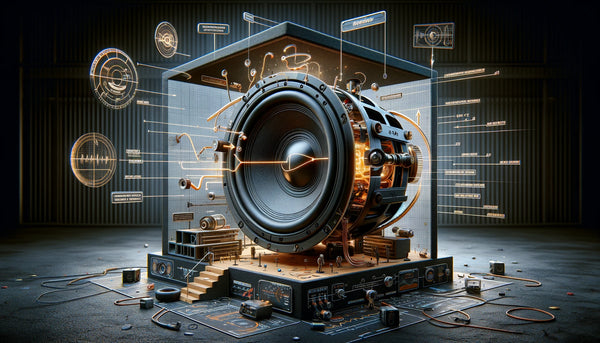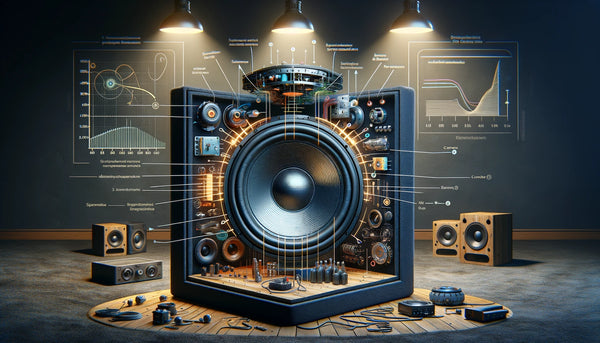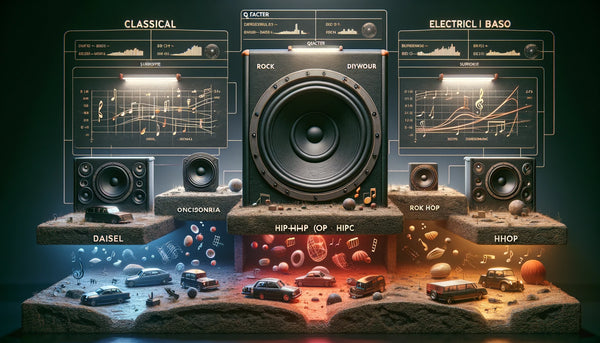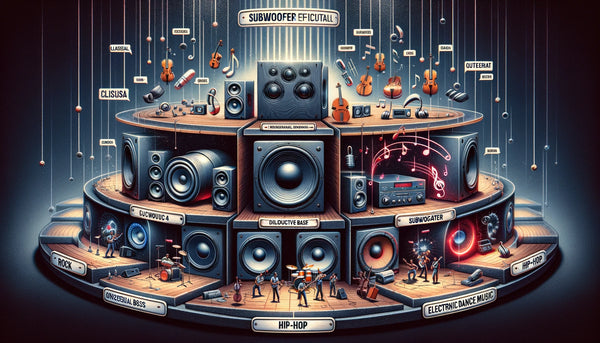Key Highlights
- The Q factor is an important parameter in audio systems affecting sound quality.
- A high Q factor indicates a narrow bandwidth, while a low Q factor indicates a wider bandwidth.
- Understanding the Q factor can help audio engineers fine-tune their systems for optimal sound.
- The q factor is important in speaker design and can affect the bass response and transient performance.
- Adjusting the Q factor can help achieve an audio system's desired sound quality and tonal balance.
- Myth: A higher Q factor always means better quality. Reality: The ideal Q factor depends on the specific application.
Introduction
The Q factor, also known as the quality factor, is a crucial parameter in audio engineering that affects the sound quality of an audio system. It measures the performance of an oscillator or resonator and describes the damping characteristics of a resonant system. The Q factor, or q values, describes a filter's bandwidth or a speaker's resonance in audio systems.
It plays a vital role in determining the sound characteristics, including the bass response, transient performance, and overall tonal balance. Understanding the Q factor, or q values, is crucial for audio engineers and enthusiasts who want to achieve the desired sound quality in their recordings or live performances, as it can affect a wider range of frequencies.
Understanding the Subwoofer Q Factor

The Q factor is an important consideration when it comes to subwoofers. It determines the bass response and the ability of the subwoofer to reproduce low frequencies accurately. The Q factor is closely related to the subwoofer's frequency response and resonant frequency (Fs/F0). A high Q factor can result in a tighter, more controlled bass response, while a low Q factor can result in a more extended, boomy bass. Understanding the Q factor of a subwoofer is essential for achieving the desired bass performance in an audio system.
The Basics of Q Factor and Its Importance
The Q factor, also known as the quality factor, measures the damping characteristics of a resonant system. In audio systems, the Q factor describes a filter's bandwidth or a speaker's resonance. It plays a crucial role in determining the sound characteristics, especially in the bass frequencies. A high Q factor indicates a narrow bandwidth, resulting in a sharper response at the resonant frequency. This can be beneficial for achieving a tight, controlled bass in a speaker system.
On the other hand, a low Q factor indicates a wider bandwidth, resulting in a more extended boomy bass. Understanding the Q factor is essential for achieving the desired bass performance in an audio system. To better visualize the impact of Q factor, we can look at a graph of equalizer responses with different Q values.
How Q Factor Influences Sound Quality
The Q factor significantly impacts the sound quality of an audio system. It affects the transient response and the overall frequency range of the system. A high Q factor can produce a more focused, precise sound with the best transient response, especially in the bass frequencies. This can benefit genres that require quick, precise bass reproduction, such as classical music or jazz.
On the other hand, a low Q factor can result in a more extended, boomy sound with a broader frequency range, which can be desirable for genres that emphasize deep, powerful bass, such as hip-hop or electronic music. Understanding the Q factor and its influence on sound quality, particularly its impact on the transient response, is crucial for achieving the desired tonal balance and overall performance in an audio system.
Technical Dive into Q Factor

To understand the technical aspects of the Q factor, it is essential to delve into some of the critical components that contribute to its calculation. The total Q factor combines a speaker system's electrical and mechanical Q factors. The electrical Q factor, denoted as Qes, is determined by the voice coil's impedance and the speaker's at the resonant frequency.
The mechanical Q factor, denoted as Qms, is determined by the stiffness of the speaker's suspension, which includes the voice coil and magnet and the cone's mass. In the context of Thiele/Small parameters, speakers have three Q values: Qms, Qes, and Qts, making understanding speaker specifications crucial for accurately assessing a speaker's performance. Understanding these factors can provide valuable insights into the performance characteristics of a speaker system.
Calculating the Q Factor: A Step-by-Step Guide
Calculating the Q factor of a speaker system involves several steps. The first step is to determine the Qes and Qms values of the speaker using the manufacturer's specifications or by conducting measurements. Once the Qes and Qms values are known, the Qts value can be calculated by multiplying the Qes and Qms values. The Qts value represents the total Q factor of the speaker system. Additionally, the Qtc value, also known as the system Q, can be calculated by considering the air's compliance in the enclosure. This value, usually between 0 and 1, is crucial in determining the ideal Q factor for a specific enclosure size. Understanding how to calculate the Q factor, including the Qtc value, is essential for designing and optimizing speaker systems for specific applications.
The Relationship Between Q Factor and Bass Response
The Q factor is closely related to a speaker system's bass response. A higher Q factor can result in a tighter, more controlled bass response, with excellent transient response and accuracy in reproducing low frequencies. This can benefit genres that require precise bass reproduction, such as classical music or jazz. On the other hand, a lower Q factor can result in a more extended boomy bass response with a broader frequency range, typically in the range of 140 to 160 Hz. However, a lower Q factor can also lead to increased overhang in the bass roll-off, resulting in decreased definition in the bass. This can be desirable for genres emphasizing deep, powerful bass, such as hip-hop or electronic music. Understanding the relationship between the Q factor and bass response is crucial for achieving the desired bass performance in an audio system.
Q Factor Variations Across Music Genres

The ideal Q factor varies depending on the music genre and the specific frequencies that need to be emphasized or controlled. Different music genres have different requirements for bass response and tonal balance. For example, classical music often requires precise, controlled bass reproduction, making a higher Q factor more suitable. On the other hand, genres like hip-hop or electronic music often emphasize deep, powerful bass, making a lower Q factor more desirable. Understanding the variations in the Q factor across different music genres, measured in hertz, can help audio engineers and enthusiasts fine-tune their systems for optimal sound performance.
Optimal Q Factor Settings for Classical Music
Classical music often requires precise, controlled bass reproduction to reproduce live performances' nuances and dynamics accurately. In this context, a higher Q factor can be more suitable. A higher Q factor can result in a tighter, more controlled bass response, with excellent transient response and accuracy in reproducing low frequencies. This can help recreate classical instruments' natural timbre and warmth, making the listener feel like they are experiencing a live performance. When fine-tuning a speaker system for classical music, it is essential to adjust the Q factor to achieve the desired tonal balance and overall sound quality.
Tailoring Q Factor for Hip-Hop and Electronic Beats
Hip-hop and electronic music often emphasize deep, powerful bass to create a dynamic and energetic sound. In this context, a lower Q factor can be more desirable. A lower Q factor can result in a more extended, boomy bass response with a broader frequency range. This can help recreate the deep, thumping bass characteristic of these genres. Audio engineers and enthusiasts can fine-tune the sound system by adjusting the Q factor to achieve the desired bass impact and overall tonal balance. It is important to note that the ideal Q factor may vary depending on personal preferences and the specific characteristics of the audio system.
Practical Guide on Measuring and Adjusting Q Factor

Measuring and adjusting the Q factor of a subwoofer can help achieve the desired bass performance in an audio system. There are various methods for measuring the Q factor of a woofer, including the bridge method, the series resonance method, and the parallel resonance method. These methods involve measuring the impedance and resonant frequency of the subwoofer and using these measurements to calculate the Q factor. Once the Q factor is calculated, it can be adjusted by changing the enclosure type, such as using a sealed enclosure, aa bass reflex enclosure, or an equalizer to fine-tune the bass response.
Tools Needed for Q Factor Measurement
Measuring the Q factor of a subwoofer requires specific tools to measure the impedance and resonant frequency accurately. One of the essential tools for measuring the Q factor is an impedance meter, which can measure the subwoofer's impedance at different frequencies. A frequency response analyzer is also necessary to measure the resonant frequency of the subwoofer. These tools can provide valuable insights into the subwoofer's performance characteristics and help calculate the Q factor. It is essential to use calibrated and accurate tools for reliable measurements and accurate adjustments of the Q factor.
Adjusting Your Subwoofer's Q Factor for Enhanced Sound
Adjusting the Q factor of your subwoofer can significantly enhance the sound quality and overall performance of your audio system. You can achieve the desired bass response and tonal balance by fine-tuning the Q factor. You can increase the Q factor to achieve a narrower bandwidth if you prefer a tighter, more controlled bass. On the other hand, if you prefer a more extended boomy bass, you can decrease the Q factor to achieve a broader bandwidth. Experimenting with different Q-factor settings can help you find the optimal balance that suits your personal preferences and the specific characteristics of your audio system.
Debunking Myths Surrounding Q Factor
There are several myths surrounding the Q factor that can lead to misconceptions about its importance and influence on sound quality. One common myth is that a higher Q factor always means better quality. The reality is that the ideal Q factor depends on the specific application and personal preferences. Another myth is that adjusting the Q factor will magically fix all sound quality issues. The Q factor is just one-factor affecting sound quality, and adjusting it alone may not solve all sound-related problems. Understanding the reality behind these myths is crucial for making informed decisions about adjusting the Q factor in an audio system.
Myth vs. Reality: Does a Higher Q Factor Mean Better Quality?
One common misconception is that a higher Q always means better sound quality. While a higher Q factor can result in a more focused, precise sound, it may not necessarily translate to better overall quality. The ideal Q factor depends on the specific application and personal preferences. In some cases, a lower Q factor may be preferred for a more extended boomy sound, while a higher One may be desired for a tighter, more controlled sound. It is essential to consider the specific requirements of the audio system and the desired sound characteristics when considering the Q factor.
Common Misconceptions About Q Factor and Bass
Another common misconception is that the Q factor solely determines the bass performance of a speaker system. While the Q factor plays a significant role in the bass response, it is just one-factor affecting bass performance. Other factors, such as the enclosure type, the speaker's size, and the driver's quality, also contribute to the overall bass performance.
Considering these factors in conjunction with the Q factor is essential when designing and optimizing a speaker system for optimal bass reproduction. Understanding the relationship between the Q and other factors can help dispel common misconceptions and achieve the desired bass performance.
Common misconceptions about the Q Factor and bass often revolve around believing that a higher Q Factor always means better quality. This is not necessarily true, as Q Factor is just one of the many factors impacting sound quality. Another misconception is that adjusting the Q Factor alone can significantly alter the bass response. Still, it's part of a more comprehensive setup that takes into account several factors. Understanding these misconceptions can lead to a more informed approach to optimizing your audio system.
Expert Tips for Fine-Tuning Subwoofer Q Factor
Fine-tuning the Q factor of a subwoofer requires careful consideration and experimentation. Here are some expert tips to help you achieve the desired sound performance:
- Start with the manufacturer's recommended Q factor range for your subwoofer.
- Experiment with different Q factor settings to find the optimal application and sound preferences balance.
- Use calibrated tools, such as an impedance meter and frequency response analyzer, to accurately measure and adjust the Q factor.
- When adjusting the Q factor, Consider the specific characteristics of your audio system, such as the enclosure type, design, and subwoofer size.
- Trust your ears and make incremental adjustments to the Q factor to achieve the desired bass response and tonal balance.
Frequently Asked Questions
What is the Ideal Q Factor for My Subwoofer?
The ideal Q factor for a subwoofer depends on the specific application and personal preferences. A higher Q factor can generally result in a tighter, more controlled bass, while a lower Q factor can result in a more extended, boomy bass. When determining the ideal Q factor for your subwoofer, it is essential to consider the frequency response, the type of enclosure used (such as sealed or bass reflex), and the desired sound characteristics.
Can Adjusting the Q Factor Improve All Types of Music?
Adjusting the Q factor can impact the sound quality of different types of music. However, the extent of the improvement will vary depending on the specific music genre and the desired sound characteristics. For example, adjusting the Q factor can help achieve a tighter, more controlled bass for classical music. In contrast, for genres that emphasize deep, powerful bass, such as hip-hop or electronic music, adjusting the Q factor can result in a more extended, boomy bass.
Can Q Factor Adjustments Damage My Subwoofer?
When making Q-factor adjustments to your subwoofer, it is essential to exercise caution and follow proper procedures. Incorrect adjustments or excessive Q factor settings can damage your subwoofer or affect its performance. It is advisable to seek professional advice or consult the manufacturer's guidelines to ensure the safety and longevity of your subwoofer.
Are There Any Tools Specifically Designed for Q Factor Adjustments?
Specific tools are available for measuring and adjusting the Q factor of audio systems. Frequency response analyzers and impedance meters are commonly used to measure the resonant frequency and impedance of subwoofers. These tools provide accurate measurements that can be used to calculate the Q factor and make precise adjustments. Using correctly calibrated tools and following the manufacturer's accurate measurement and calibration guidelines is essential.
What Are the First Steps in Adjusting My Subwoofer's Q Factor?
The first steps in adjusting your subwoofer's Q factor involve measuring the resonant frequency and impedance of the subwoofer using appropriate tools. These measurements can then be used to calculate the Q factor and make initial adjustments. It is advisable to start with minor adjustments and fine-tune the Q factor gradually to achieve the desired bass performance.
Conclusion
In conclusion, unraveling the mystery of the subwoofer Q factor sheds light on its pivotal role in shaping sound quality. From understanding the basics to tailoring settings for different music genres, optimizing the Q factor can significantly enhance your audio experience. By debunking myths and offering expert tips for fine-tuning, achieving the perfect bass response becomes achievable. Real-world applications showcase the transformative power of Q factor adjustments in home theaters and professional sound systems. Whether you seek the ideal settings or guidance on measurement and adjustment, mastering the Q factor elevates your audio setup to new heights of precision and clarity.





